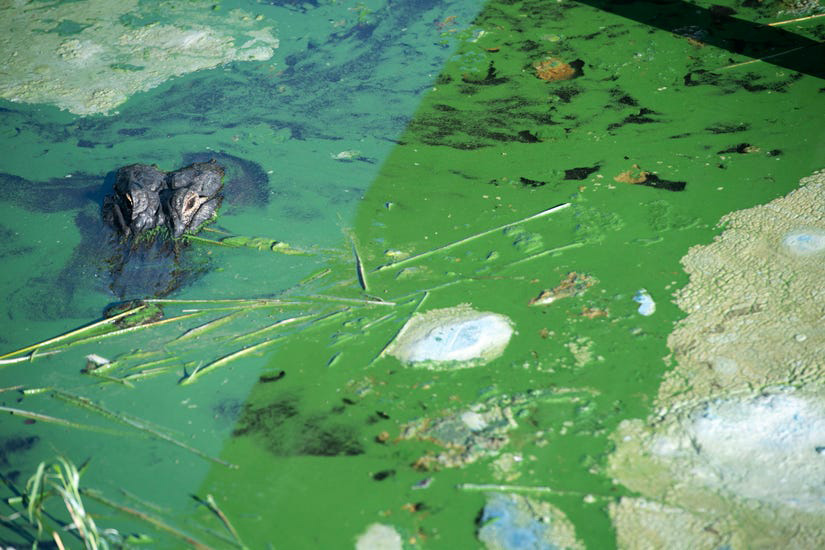
Terry Butler was beginning his eight-hour shift at the Pahokee Campground & Marina early Wednesday as government officials began gathering to address toxic algae that could be unleashed on the Treasure Coast if Lake Okeechobee discharges resume.
Butler spends his weekdays working at the marina, where he cleans boats, trims hedges and, for the past few weeks, has carefully weaved his way around the docks trying to avoid the putrid scent algae releases at his workplace.
“It’s really hard for me to smell it every day. But I’ve got to come to work,” the 55-year-old Pahokee city employee said. “I don’t know about the risks. I’m not aware of what it is … but every year, it comes in from somewhere else.”
Toxic algae poses a health risk
The algae — blooming just feet from where Butler stood — contained 860 parts per billion of the toxin microsystin, state data updated Wednesday shows. At 8 parts per billion, microsystin makes water too hazardous to touch, ingest or inhale for people, pets and wildlife, according to the U.S. Environmental Protection Agency.
As coastal residents along the Treasure Coast ramp up environmental education and activism in the face of the looming Lake O discharges, some are saying inland communities are facing environmental racism.
“Although the cyanobacteria itself doesn’t discriminate, broken policy dictates that particular communities are hurt more than others,” Lake Worth Waterkeeper Reinaldo Diaz wrote in an April 10 blog post.
The troubles plaguing Lake O aren’t new, former Pahokee Mayor J.P. Sasser wrote in an email to TCPalm Wednesday.
“I am 66 years old and every summer, Lake O turned green with algae,” he said. “We swam in it, water-skied in it and we eat the fish out of it.”
The potential threat of toxic algae sliming the St. Lucie River, Indian River Lagoon and Atlantic Ocean beaches this summer prompted U.S. Rep. Brian Mast, R-Palm City, to visit Pahokee to see it for himself. As he began his news conference at the marina, Butler picked up his weed whacker and started his workday.
“We’re not going to take this in my community,” said Mast, who represents Martin, St. Lucie and parts of north Palm Beach counties. “I can’t speak for every community, but I know they don’t want this here in Pahokee. They don’t want it in the Lake Worth Lagoon. And they don’t want it in the St. Lucie.”
Bills meant to curb Lake O discharges
Lake O’s level was 14 feet, 1 inch Wednesday, about 1½ feet higher than the 12½ feet the Army Corps of Engineers wants it by June 1 to make room for heavy summer rains.
The Corps ceased discharges April 10, citing the toxic algae as a factor.
Mast used the backdrop of rotten-smelling, guacamole sludge as an opportunity to tout his latest suite of bills meant to curb Lake O discharges carrying toxic algae to coastal estuaries.
The three bills aim to keep toxic algae out of the St. Lucie River, prioritize public health and alert people to the hazards of Lake O discharges.
Toxic algae can cause nausea and vomiting if ingested, and a rash or hay fever symptoms if touched or inhaled. Drinking the water can cause long-term liver disease. Some research indicates a link between long-term inhalation and neurological ailments such as Alzheimer’s, Parkinson’s and Lou Gehrig’s disease
One of the bills, dubbed the Stop Poisoning Florida Act, would prohibit the U.S. Army Corps of Engineers from discharging lake water into the St. Lucie River if it contains a toxicity level of over 8 parts per billion microsystin.
“I don’t care if I have to anchor myself in my rowboat to our lock and dam,” Mast said, referring to the St. Lucie Lock & Dam that connects Lake O to the St. Lucie River. “I don’t care if they lock me up and put me behind bars for filling in a canal. They will not poison my community with this crap.”
Steve Carr, a Lake City native who has lived on a sailboat at the Pahokee Marina since November, has been up-close and personal with the toxic algae over the last few weeks.
Algae blooms typically grow in size and toxicity during the warmer, wetter summer months. As April nears its end, Carr said he thinks his health is at risk, and he expects the environmental conditions to deteriorate as the temperatures rises.
“I intended to ask some of the guys who have been around here longer if they’ve seen it like this before,” he said. “Because if it has been, I don’t want to be around here all summer.”
Commissioner calls on state to act
Marinas are ripe for the deteriorating environmental conditions unfolding in Pahokee. A closed-in structure from docks and seawalls blocks wind from breaking up the blooms, so they coagulate.
On the Treasure Coast, Stuart-based Central Marine has faced the same problem in the summers of 2013, 2016 and 2018, when toxic algae smothered the water and shorline.
“That makes it especially dangerous in these kinds of areas,” Mast said.
Palm Beach County Commissioner Melissa McKinlay called on the state to intervene and take over operations at the Pahokee Marina Wednesday.
“What I think we’re seeing here is a poorly run operation,” McKinlay said, citing renovations, the lack of a full-time dockmaster and inoperable dock pumping stations.
Responding to Carr challenging her claim that boaters have dumped sewage waste in the marina, McKinlay said, “There are historical problems (and) we do hear complaints from some of the people that are living here at the campgrounds. Historically, those systems have not been working.”
The problem extends much farther than the Pahokee Marina, said Everglades Foundation CEO Eric Eikenberg.
“This is an impaired body of water. This has nothing to do with Marina of Pahokee, in my judgement. Lake Okeechobee is impaired. This lake is battered. This lake is in desperate need of change,” Eikenberg said.
One solution would be addressing the pollution heading into Lake O from the north — mostly nitrogen and phosphorus from farm and urban stormwater runoff. Another would be state-operated marshes, called “stormwater treatment areas,” to remove fertilizer pollutants that feed algae, and to send excess water south to the thirsty Everglades.
Pahokee Vice Mayor Regina Bohlen pledged to work on the marina issues.
“We want to do everything we can to get this cleaned up,” she told TCPalm.
For more news, follow Max Chesnes on Twitter.
Max Chesnes is a TCPalm environment reporter covering issues facing the Indian River Lagoon, St. Lucie River and Lake Okeechobee. You can keep up with Max on Twitter @MaxChesnes, email him at max.chesnes@tcpalm.com and give him a call at 772-978-2224.
